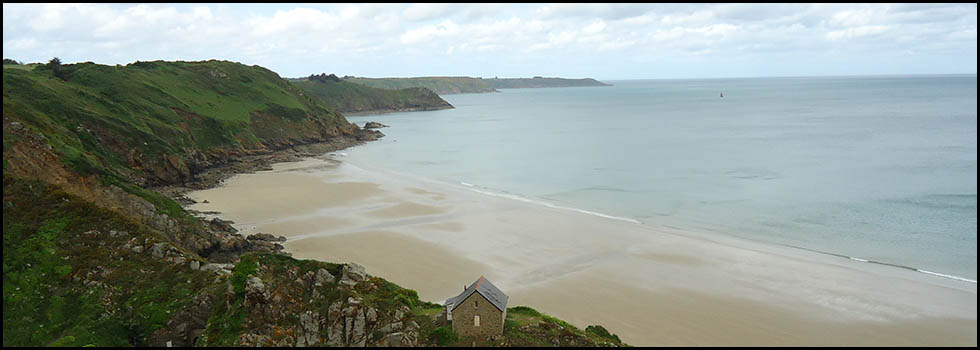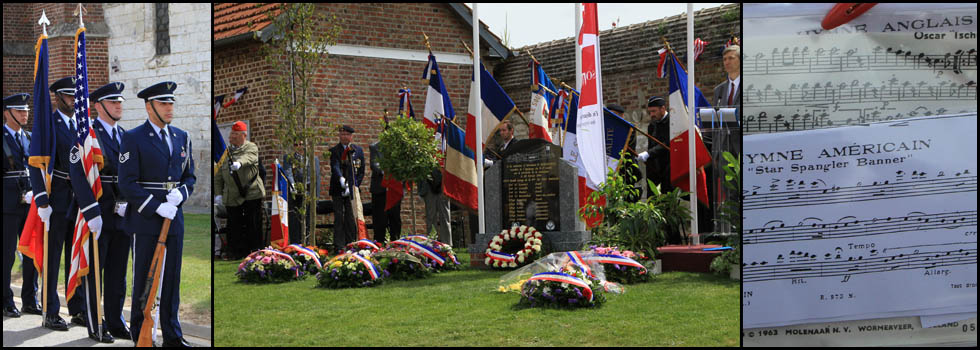March 18, 1945
Mid-air collision of three B-26s "Marauder"
# 43-34409
# 43-34422
# 43-34155
322nd Bomb. Group
451st Bomb. Squadron
9th Air Force
Goincourt (Oise)
Copyright © 2025 - Association des Sauveteurs d'Aviateurs Alliés- All rights reserved -
En français ![]()
March 1945
Our region was liberated by the Allied Armies after four years of Occupation, but in Europe the war was still not over.
The enemy, who had retreated, still held on to the pockets of Royan, Saint-Nazaire, Lorient and Dunkirk.
The main focus of the fighting was now on Reich territory. Since March 7, American troops had crossed the Rhine at Remagen, and a major Allied offensive was being prepared to occupy the Ruhr in a Germany that still refused to surrender.
As soon as our region was liberated, the American Air Force moved to bases previously occupied by the Germans, to be closer to the front. In September 1944, the 322nd Bomb. Group, 9th Air Force, equipped with B-26 “Marauder” medium bombers, took over Beauvais-Tillé, an airfield it had previously bombed on several occasions when occupied by the Luftwaffe.
Based in encampments on the outskirts of the airfield, all personnel not only had to face the enemy on home soil, but also had to battle the extreme temperatures and snow of that terrible winter of 1944/1945.
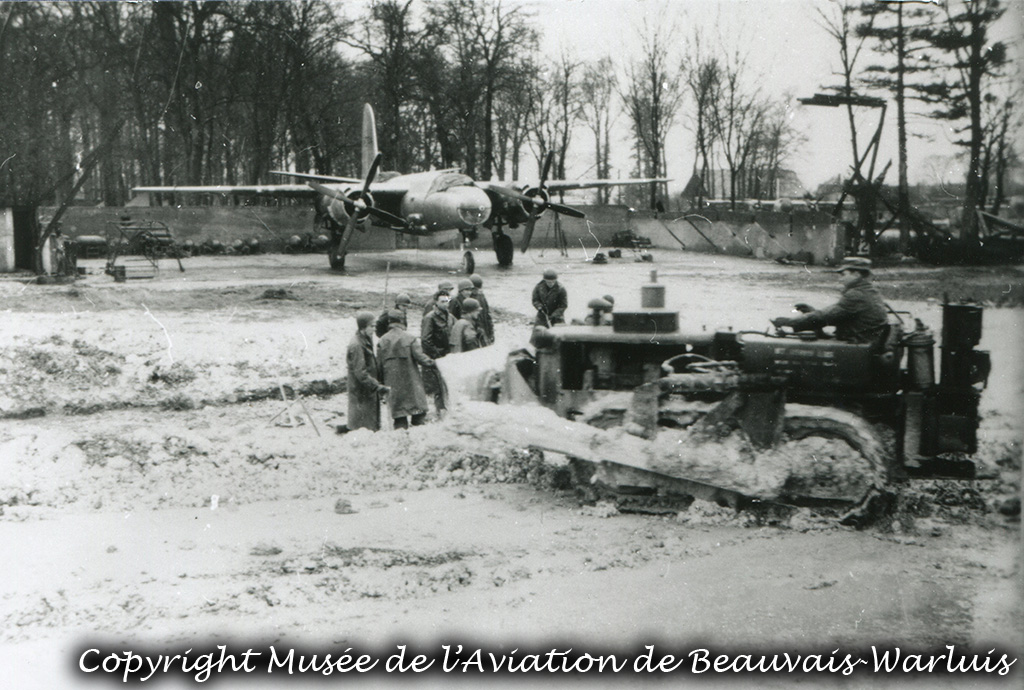
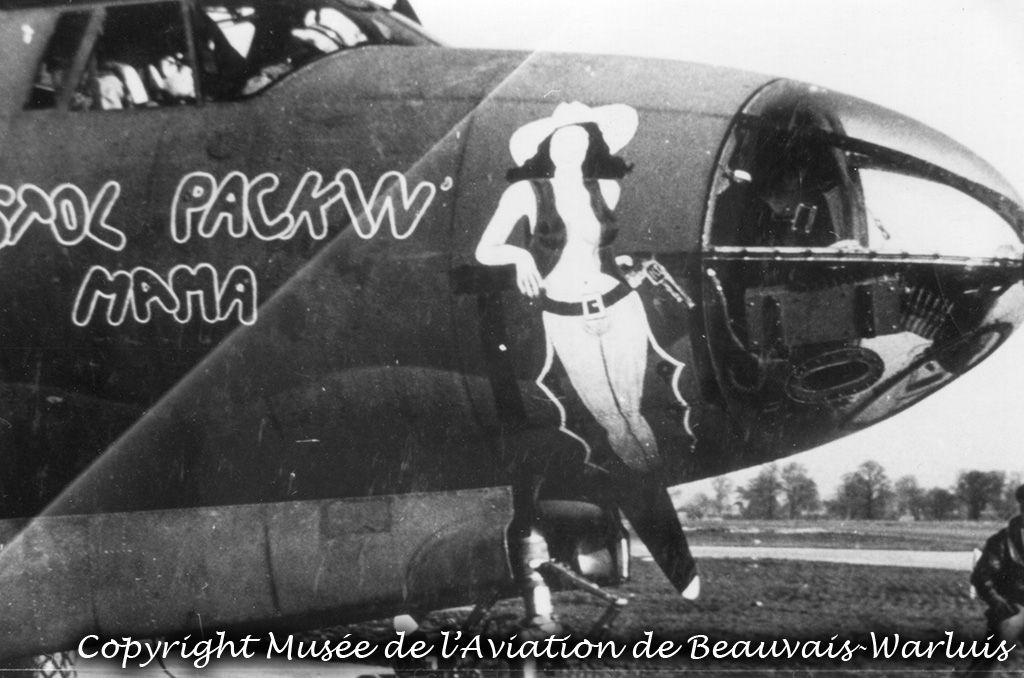
March 17, 1945
St. Patrick's Day ! For some of them, who were of Irish origin, it was an opportunity to celebrate in town or on leave in Paris. Meanwhile, the war continued. There was no question of the Command granting itself a truce. With the weather forecast to be favorable, a mission was already announced for the following day.
In the Operations Office, the officer of the 451st Bomb. Squadron, due to the number of airmen on leave, was busy drawing up an improvised list of twelve crews for a bombing mission over the German town of Bad Dürkheim.
The Command appointed 1st Lt. Alex Cordes as the formation's lead pilot. His crew would consist of a total of seven men, as opposed to the usual six.
March 18, 1945
After an early-morning briefing outlining the various aspects of the mission, the crews climbed into their aircraft, loaded with almost two tons of bombs.
At around 8:00 a.m., the B-26s “Marauder” of the 322nd Bomb. Group headed for the runway.
A green flare gave the order to take off. One by one, every thirty seconds, the aircraft took off into the clear, sunny sky, gathering in groups of six around 1st Lt. Cordes' lead aircraft. This formation phase was one of the most critical moments of the mission.
At an altitude of 1,000 feet, while making a wing turn over the village of Goincourt, the B-26 of 1st Lt. Cordes was suddenly struck by that of 2nd Lt. Shettles. Literally split in two, loaded with fuel and bombs, Lt. Cordes' aircraft exploded in a fraction of a second.
A 3rd aircraft, piloted by 1st Lt. Lester Barton, was caught in the blast. At too low an altitude and losing control, the aircraft crashed to the ground, killing all on board.
The crews :
B-26 # 43-34409
|
1st Lt. Alexander O. CORDES |
Pilot |
California |
|
|
2nd Lt. Roy L. RICE Jr |
Co-pilot |
21 |
Michigan |
|
Capt. George A. SNOKELBURG |
Navigator |
26 |
Wichita, Texas |
|
2nd Lt. Wesley M. MYERS |
Bombardier |
29 |
Burbank, California |
|
T/Sgt. Thomas B. COLLEY |
Radio-operator |
24 |
New Orleans, Louisiana |
|
S/Sgt. Jack L. CALLAWAY |
Engineer |
24 |
Houston, Texas |
|
S/Sgt. Jack E. FOX |
Tail gunner |
20 |
Bennett, Colorado |
B-26 # 43-34422
|
2nd Lt. James A. SHETTLES |
Pilot |
25 |
New Albany, Mississipi |
|
2nd Lt. Lawrence F. WATSON Jr |
Co-pilot |
21 |
Spartanburg, South Carolina |
|
2nd Lt. Victor CASTON |
Bombardier |
22 |
Los Angeles, California |
|
Sgt. Frank WITTIG |
Radio-operator |
25 |
South Union, Kentucky |
|
Sgt. Joe F. PRATT |
Engineer |
24 |
Mineral Wells, Texas |
|
Sgt. James J. FOLLEY Jr |
Tail gunner |
20 |
Chesson, Alabama |
B-26 # 43-34155
|
1st Lt. Lester E. BARTON |
Pilot |
26 |
Worthington, Alabama |
|
2nd Lt. Ernest L. MOFFIT Jr |
Co-pilot |
24 |
Pawtucket, Rhode Island |
|
2nd Lt. John W. REGMUND Jr |
Bombardier |
20 |
Corpus Christi, Texas |
|
Sgt. Manuel S. ESCAMILLA |
Radio-operator |
20 |
Laredo, Texas |
|
Sgt. John W. TEMPLETON |
Engineer |
27 |
Wellington, Texas |
|
Sgt. Thomas E. LAMB |
Tail gunner |
20 |
Grosse Pointe, Michigan |

Lester E. Barton, Ernest L. Moffit Jr, John W. Regmund Jr, John W. Templeton, Manuel S. Escamilla, Thomas E. Lamb
Miraculously protected by the armor plate of his seat, only 1st Lt. Cordes, after being literally ejected from his aircraft, managed to activate his parachute in extremis and hit the ground hard, simply spraining an ankle.
The collision of the three aircraft and the loss of the lead aircraft did not, however, result in the cancellation of the mission. The remaining B-26s joined other squadrons and headed for their target in Germany.
This appalling tragedy took the immediate lives of 18 young American airmen.

Photo from Missing Air Crew Report
On the ground, it was horror. Their bodies were removed from the wreckage and transferred to a temporary cemetery in Etampes, southwest of Paris. Ten of them were later repatriated to the USA. The remaining eight (2nd Lt. Rice Jr, 2nd Lt. Myers, 2nd Lt. Caston, Sgt. Pratt, Sgt. Jolley Jr, 2nd Lt. Regmund Jr, Sgt. Templeton and Sgt. Lamb) now lie in the American military cemetery in Epinal, Vosges.

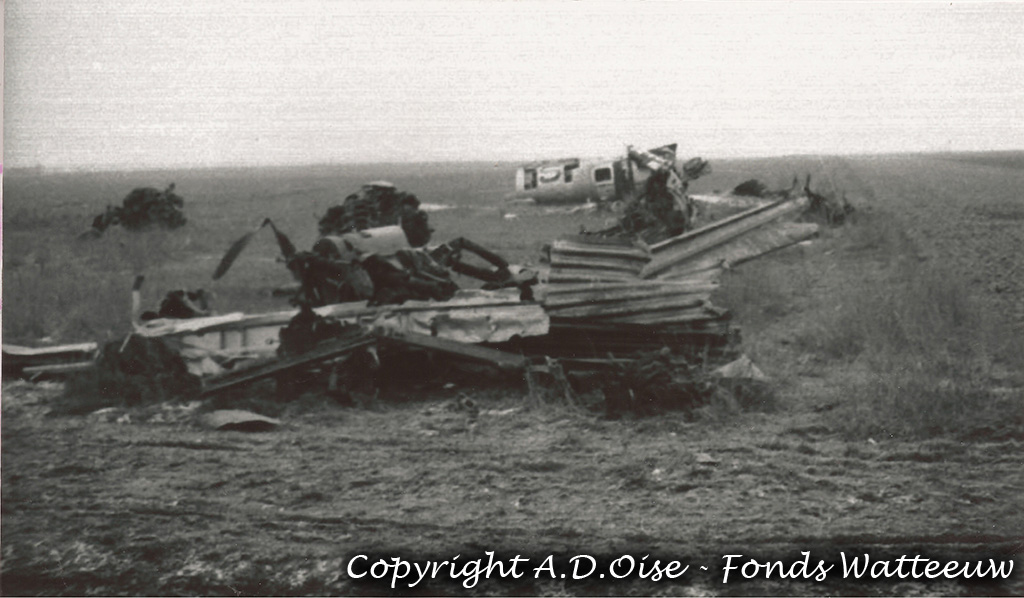
This terrible tragedy left an indelible mark on the life of 1st Lt. Alexander Cordes, who for a long time felt a sense of guilt at having been the sole survivor. But the very next day, he was back in the air, and soon back on missions. After the war, he continued his career as a commercial pilot with Northwest Airlines.
In the 2000s, a resident of Goincourt, Mr. Cocu, was surprised to find a bracelet in his garden bearing the serial number and name of Sgt. Thomas E. Lamb. On June 13, 2015, this bracelet was finally handed over to his descendants.
In 1996, a memorial was erected to commemorate the presence of the 322nd Bomb. Group from September 1944 to April 1945 was installed near the control tower at Beauvais-Tillé airport. Twenty years later, however, with the development of the airport area, the stele had become isolated and inaccessible to the public. For greater visibility, it was moved near the church in the village of Tillé and, on September 24, 2016, was unveiled in the presence of Mrs. Patricia Newcomer, daughter of Lieutenant-Colonel Henry Newcomer who commanded the 451st Bomb. Squadron at the time.

18th August 1944
Squadron Leader Eugeniusz HORBACZEWSKI
"Mustang III" # FB355
PK-K
315 Polish Squadron "Debliński"
Velennes (Oise)
Copyright © 2018 - Association des Sauveteurs d'Aviateurs Alliés- All rights reserved -
En français ![]()
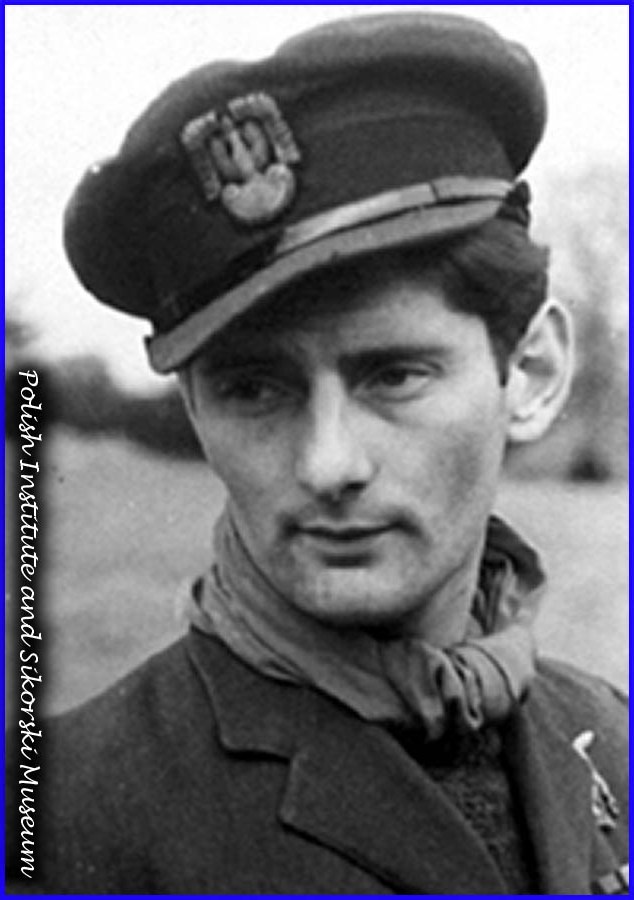
Eugeniusz Horbaczewski was born on 28th September 1917, in Kiev (now in Ukraine), to Polish parents.
Attracted by the Aviation, in 1935 he obtained his glider pilot's license on the Ustianowa field before continuing, in 1936, his secondary studies at Brzesc (now Brest-Litovsk, in Belarus).
In 1937, at Bielsko-Aleksandrowice, he began his apprenticeship as a pilot of a powered airplane.
In January 1938 he joined the Deblin Cadet Polish Air Force School.
On 1st September 1939, he graduated as a fighter pilot in the Polish Air Force the very day the German Army invaded his country without a declaration of war. Although a novice, between 9th and 11th September, he made 3 reconnaissance missions during the Battle of Poland.
The swift defeat of the Polish Army against the German invader gave birth to a deep sense of revenge. On 17th September, without a declaration of war, the Soviet Army, in turn, entered Poland. At the end of October, after many difficulties and like many Polish airmen, he managed to reach Rumania and, via Yugoslavia and Greece, he joined France and the Bordeaux-Merignac base.
On 10th May 1940, the Wehrmacht attacked the West. Six weeks later, the defeat was consumed on French soil. On 22nd June, the armistice was signed in the clearing of Rethondes, near Compiegne.
On 24th June, S/Lt Horbaczewski arrived in extremis, with many compatriots, to embark aboard a ship, from the port of Saint Jean-de-Luz, to Liverpool, England, to continue the fight.
In the summer of 1940 he joined the Royal Air Force and the Bristol School for an accelerated training on British equipment.
At the end of August 1941, Eugeniusz Horbaczewski was assigned to 303 "Kościuszko" Polish Squadron, integrated into the Royal Air Force. Within this Squadron his war missions began over the Channel facing a Luftwaffe then at its zenith. On board his Spitfire Mk V, he recorded his first victory on 4th April 1942 by shooting down a Focke-Wulf 190 over the Pas-de-Calais. His second victory was on 16th April and a third on 19th August during Operation Jubilee at Dieppe. He showed himself to be a talented pilot.
On 15th July 1941, he was transferred for a few days to the 18 OTU specialized in the training of bomber pilots before joining the 58 OTU which trained the fighter pilots on the famous Spitfire.
From 10th September 1942, he joined 302 "Poznański" Polish Squadron. Aerial fights were exhausting. At that time, he had already flown 65 war missions. Given leave on 3rd December 1942, he went back to 58 OTU, this time as an instructor, with the rank of Flying Officer.
At the beginning of 1943, he volunteered to fight the Afrikakorps. In Tunisia, he and other Polish pilots formed the famous "Skalski Circus". Voluntary certainly, but retained after a drastic selection of 16 pilots.
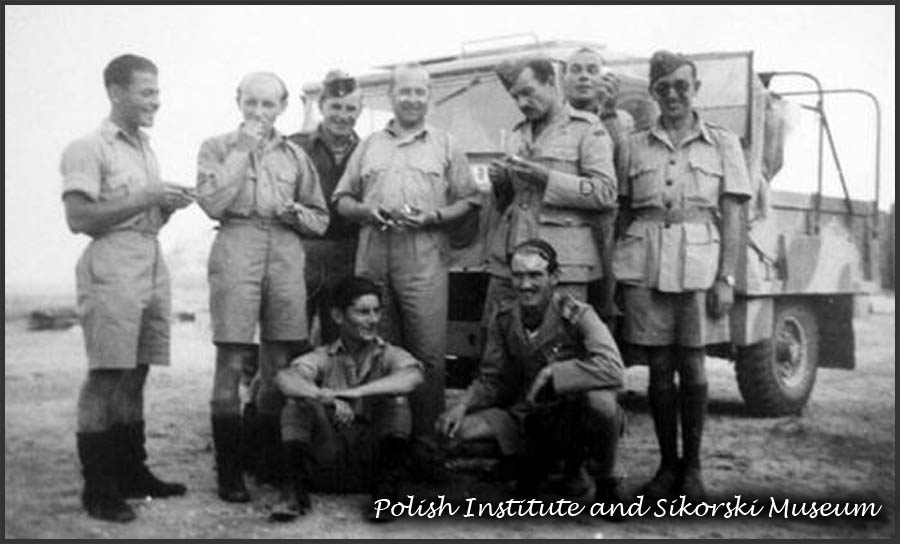
Polish Fighting Team in Tunisia – Eugeniusz Horbaczewski is seated on the left.
In the Polish Fighting Team under the command of S/L Stanislaw Skalski, Eugeniusz Horbaczewski's talent as a fighter pilot literally exploded. In less than two months (from 18th March to 12th May), the intrepid Polish pilots, aboard their Spitfire Mk IX, created a sensation with the Allied High Command by destroying 25 aircraft of the Luftwaffe and of the Italian Regia Aeronautica + 3 probable. Lieutenant Horbaczewski was the most successful pilot of the "Skalski Circus" with 5 victories: four Messerschmitt-109 and a twin-engined Junkers 88 were shot down under by his machine-guns in 41 war missions. Since the beginning of the conflict, he had 8 confirmed victories. In high places, his vista was noticed.
After the dissolution of the Polish Fighting Team, Eugeniusz Horbaczewski remained on the Mediterranean front while most other pilots joined Great Britain.
North Africa liberated, he left Tunisia for Malta. He first joined 601 RAF Squadron and then joined 43 Squadron of the Desert Air Force on 6th July 1943, taking command on 9th August. In the sky of Sicily and southern Italy he again shot down three enemy aircraft.
On 20th October, he was finally recalled to Great Britain, where the Allied invasion of the continent, somewhere between northern Brittany and the Belgian coast, was being prepared under the seal of secrecy.
At the end of 1943, Eugeniusz Horbaczewski had 11 victories + 1 probable + 1 damaged.
In January 1944 he was posted to the Northolt airbase for conversion to a new aircraft, the North American P-51 “Mustang III”.
On 15th February, he took command of 315 "Debliński" Squadron of the 2nd Tactical Air Force, recently created for the exclusive needs of the future invasion. He was officially promoted Squadron Leader.
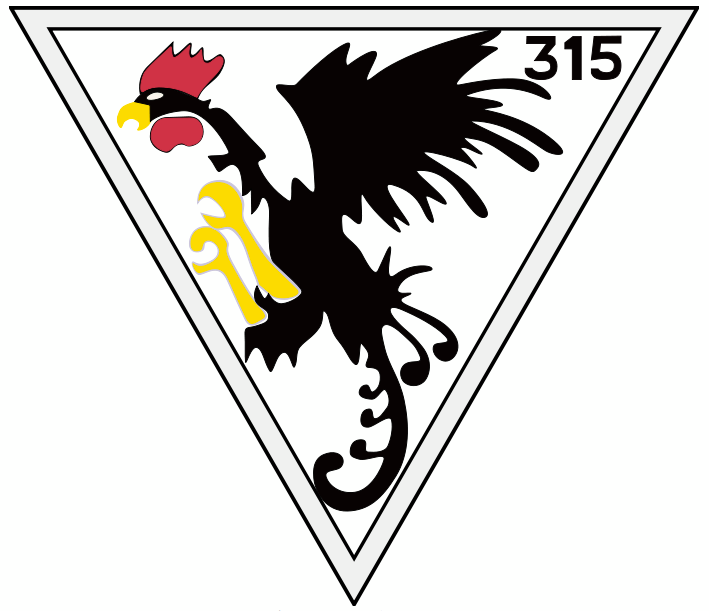
On 20th February, at the head of his Squadron, he began his missions. 57 others would follow over France, from northern Europe to Norway, leading dangerous attacks at low altitude on marshalling yards, port facilities and other Nazi strongholds, all bristling with the formidable Flak: the very dense defence against planes.
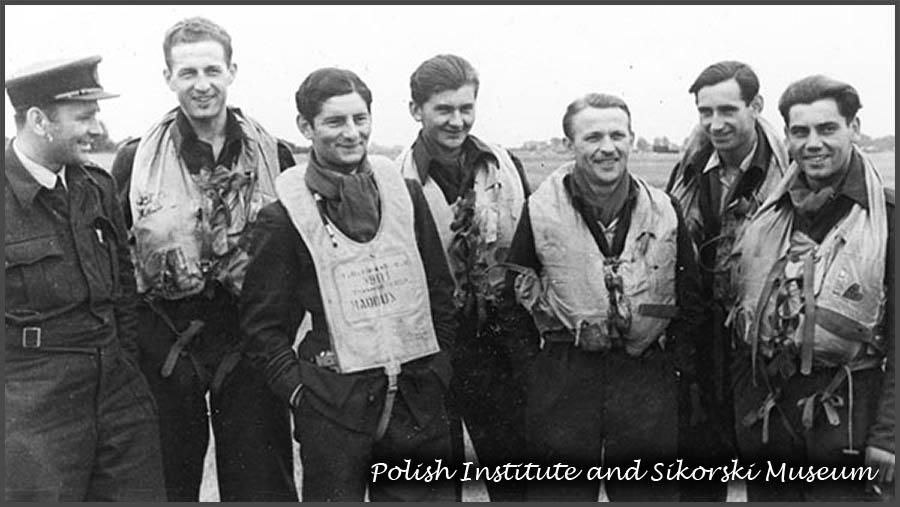
F/Lt Przymienski, F/O Swistun, S/L Horbaczewski, F/O Nowosielski, F/Lt Cwynar, W/O Jankowski and W/O Bedkowski.
After the Normandy Landings on 6th June 1944, another arduous task was added to the airmen of 315 Squadron: to chase from the English skies the V1s, the Nazi very lethal flying bombs which terrorized and tried to demoralize the civilian population. S/L Horbaczewski shot down four of them.
The battle of Normandy was raging. On 22nd June, during a fierce ground attack on German positions in Cherbourg harbour, Squadron Leader Horbaczewski spotted Sgt Tamowicz's Mustang III, seriously hit by Flak. The pilot was forced to land, as soon as possible, between the enemy and American lines, in a marshy area of the Cotentin Peninsula. Eugeniusz Horbaczewski, who had watched the scene, circled above his Squadron companion. Although injured in his legs, Sgt Tamowicz managed to get out of his plane, indicating to his Leader that he was safe.
With the spirit of decision that animated him permanently, Eugeniusz Horbaczewski landed on Azeville airfield only just fitted out by the Americans. Immediately borrowing a Jeep, he headed for the area where his teammate's aircraft was.
Meanwhile, Sgt Tamowicz's Mustang sank deeper and deeper into the mud. To his surprise, the pilot suddenly saw Eugeniusz Horbaczewski coming to rescue him. Wading in the marsh, the two men managed to join the Jeep then the Allied lines and finally Horbaczewski's aircraft. Although planned for one man, Tamowicz then took his place in the Mustang cockpit before his Squadron Leader sat on the knees of his moaning companion.
Reaching the end of the runway, the aircraft took off full throttle towards England under the hoorays of the American soldiers who had witnessed the scene.
After landing at Coolham, Horbaczewski and Tamowicz were this time cheered by the staff of their own Squadron, stunned to see two men get out of the cockpit of the Mustang. Sgt Tamowicz was quickly transferred to a hospital and treated.
Those who attended this scene always remembered the heroic action and the panache of Eugeniusz Horbaczewski. This unusual rescue remained in the annals of the Royal Air Force.

During the summer of 1944, the Polish pilots of 315 Squadron also carried out bombing escort missions to the distant Norwegian ports. S/L Eugeniusz Horbaczewski, nicknamed "Dziubek", fully fulfilled his role, advising caution to the impetuous neophytes who were there to learn. These raids were often difficult. Around these targets, the Flak was more than dense. The return was long with sometimes some of the aircraft damaged.
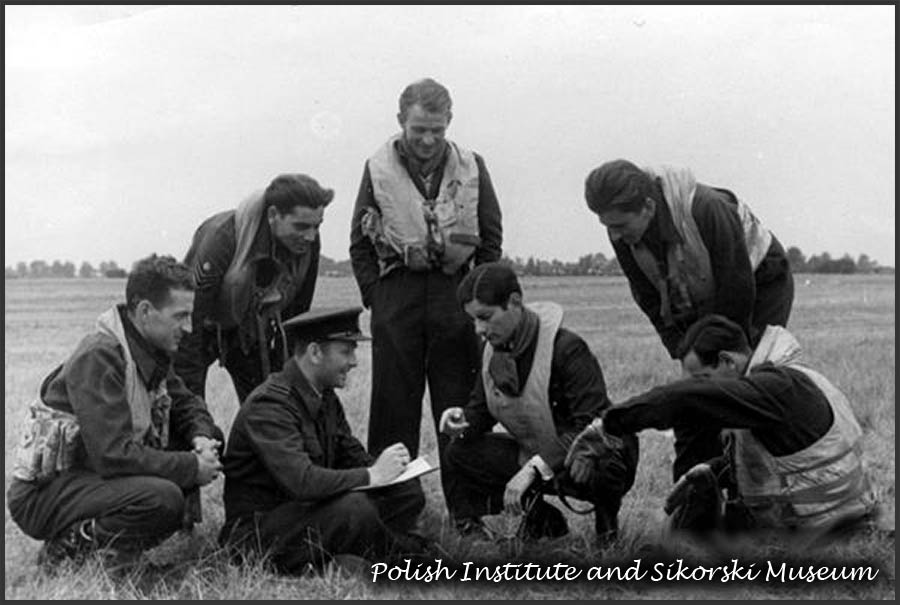
At the end of July, he obtained even more credits, totalling at that time 14 victories (including 1 shared).
On Friday 18th August 1944, the mission "Rodeo 385" was decided by Fighter Command. The Polish pilots of 315 Squadron were ordered to patrol the triangle formed by the cities of Boulogne-sur-Mer, Le Havre and Paris and to destroy any target on the ground just as in the air.
S/L Horbaczewski had been suffering from severe bronchitis with fever for several days, but ignored medical advice which tried to dissuade him from flying. Horbaczewski had the presentiment this time that in case of confrontation with the enemy he would not come back. He decided, however, to carry out the planned mission.
On Brenzett airfield, 12 "Mustang III" of 315 Squadron took off around 7:15 am and then headed for the English Channel: radio code "Central"!
A passage and a possible attack of the airfield of Abbeville-Drucat were planned but the air base seemed deserted ... The Polish pilots then took the direction of Beauvais-Tillé, a dangerous aerodrome, above which, in the past, the Royal Air Force had suffered losses.
At least three dozen enemy aircraft came against them ... Although the radio silence was broken, the pilots of 315 Squadron did not hear as usual their Leader give them the latest instructions, advise them and direct them in the fight ... These were JG 26's Focke-Wulf 190 A8s. Others were seen taking off, just seconds apart, waving the grass of the airfield.
The bad surprise was total for the German airmen. Having dropped their extra tanks, the Poles emerged from the sun, burst onto the enemy and literally grabbed him by the throat... Although feverish, flu victim and with a radio broken down, their leader led his Squadron masterfully with his eleven teammates sticking together. On the German side, an unusual outburst went to squadrons on takeoff or already in the air. Eugeniusz Horbaczewski shot down two Focke-Wulf 190s in quick succession.
After a violent reversal, another Focke-Wulf appeared in his collimator and quickly shot down in flames. A fourth was seriously hit. The dogfight was raging. The Polish airmen wreaked havoc and then abruptly the fighting stopped.
Very quickly the pilots of 315 Squadron noticed the absence of their Squadron Leader. All had seen him shoot down three enemy aircraft but nobody in the following attacks had seen him disappear. They returned to fly over the place without observing anything concerning him. With a heavy heart, the Polish pilots regrouped and then returned to England. The sixteen Focke-Wulf 190 claimed as destroyed did not mitigate their immense sadness.
In Velennes, a small village near the Beauvais-Tillé airfield, three young boys, Daniel Loncke, 14, and Constant Loncke, 7, were in front of the family farm gate with their 8-year-old friend Michel Lasne. Accustomed to aerial combats above their heads, they observed the one on that morning of 18th August rather distractedly despite its magnitude. Suddenly, the kids heard a plane engine whistling abnormally. Behind a row of trees, a huge thud was heard, followed by a gigantic cloud of black smoke rising high in the sky ... No explosion! In the next few minutes, the children learned that an aircraft from the aerial combat had gone into a dive, and stuck deeply into the soft ground of a field. The aircraft was broken into two parts. The engine was completely buried, as if it had disappeared. The fuselage was broken at the cockpit, almost intact, revealing the British cockade.

Velennes - The crash site
Around 9:30, the smoke stopped escaping from the wreckage but no one dared to get too close to the allied aircraft. The cockpit appearing empty, the majority of witnesses, just like the Germans, thought that the pilot had parachuted out. Luftwaffe "ground crews" retrieved the machine guns from the wings detached from the fuselage.
As evening approached, at the crash site, the plain of Velennes found calm after the dramatic effervescence started early in the morning. After 4:30 pm, no more villagers walked, no more German soldiers were busy around the plane.
It was at this moment that five children of about ten years old appeared as a friendly symbol. Michel Lasne, accompanied by his brother and his sisters, laid a large bunch of dahlias near the wreckage of the unmanned aircraft ... and then left quickly.
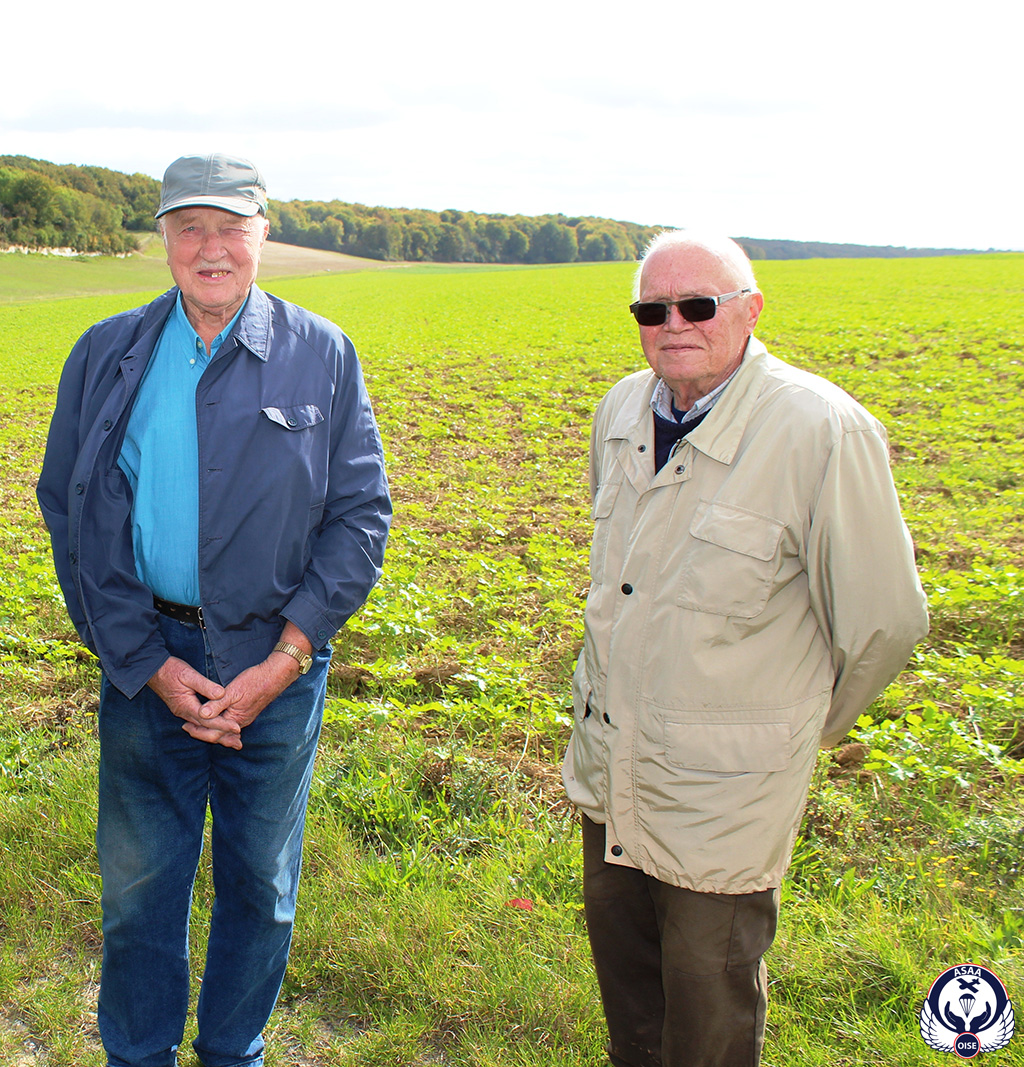
Velennes, October 2017 - Michel Lasne and Constant Loncke at the crash site.
For the two friends, the drama of 18th August 1944 remains an indelible memory.
At the end of August 1944, the Liberation was imminent. Everyone forgot the plane. It was time for joy to be liberated soon. The British Army being at the gates of Beauvais, the Germans blew up their installations at Beauvais-Tillé before evacuating. The end of four years of misery was approaching.
In October, the farmer who owned the field harnessed his horses and had them pull back the fuselage before filling in the hole containing the engine. He could then cultivate again.
At the beginning of 1946, prison camps in Germany were emptied but there was still no trace of Squadron Leader Eugeniusz Horbaczewski.
In late 1946, a Research Commission of the Royal Air Force Missing Airmen in cooperation with the French Red Cross, conducted searches in the Beauvais-Tillé area.
At the beginning of 1947, the identified remains of the Polish officer were finally found at the crash site in Velennes. In the extreme violence of the shock, the pilot's body had slipped under the engine of his aircraft and remained in the ground. His remains were buried in Creil, where he has since been resting with 54 other Royal Air Force airmen who fell in the Creil area and most of them during the terrible year 1944.

His grave in the cemetery of Creil (Oise)
Third best Polish fighter Ace during WWII, S/L Horbaczewski flew a total of 250 war missions during which he had 16 confirmed victories + 1 shared + 1 probable + 1 damaged and 4 flying bombs V1 shot down.
Distinguished Service Order
Distinguished Flying Cross + bar
Virtuti Militari (2 Silver + 1 Gold posthumously) – Polish
Polish Cross of Valour and 3 bars (4 times)
On 23rd June 2018, a memorial honouring Squadron Leader Eugeniusz Horbaczewski was unveiled in the village of Velennes (Oise).
4th August 1944
Victoria Cross, Distinguished Flying Cross
Avro Lancaster MkIII ND811
F2-T
RAF 635 Squadron
Senantes (Oise)
Ian Willoughby Bazalgette was born on 19th October 1918 in Calgary, Canada, from Anglo-Irish parents, third child of a family running a farm.
His father, who had been wounded and gassed in the First World War, still suffered the after-effects. Having difficulty in administering his farm, he finally gave up his job.
During his youth, he developed a passion for writing music, reading and photography.
In July 1939, a few months before the outbreak of the Second World War, Ian W. Bazalgette enlisted in the Royal Artillery and found himself assigned in Scotland, to the 51st Highland Searchlight Regiment which was equipped with radar controlled searchlights.
From 1940, the Battle of Britain began. The Luftwaffe of Marshal Goering first attempted to destroy the British convoys in the English Channel and then took on in vain the Royal Air Force before starting the “Blitz”, the bombing of London and other large British cities.
In 1941, wanting to become more involved in the war, Ian W. Bazalgette got his transfer to the Royal Air Force which was in need of pilots. In June, he went back to England, to the n° 22 Elementary Flying Training School in Cambridge. After ten hours of dual instruction, he took his first solo flight in a Tiger Moth on 3rd August 1940.
 Over the months, Ian W. Bazalgette passed successively through various flying schools of the RAF, learning to fly twin-engined planes.
Over the months, Ian W. Bazalgette passed successively through various flying schools of the RAF, learning to fly twin-engined planes.
On 30th September 1942, piloting a twin-engined Vickers Wellington with crew, Pilot Officer Bazalgette flew his first mission over Holland.
From that time until the end of 1942, night missions over enemy territory became almost routine for P/O Bazalgette and the crews of 115 Squadron. Meanwhile, in November, he was promoted to Flying Officer.
In February 1943 a new aircraft, the four-engined Lancaster, began to replace the Wellingtons of 115 Squadron, requiring pilots and crews to be converted.
His first mission aboard this new aircraft comprising a crew of seven men was on the night of 22nd to 23rd March 1943. It was the bombing of Saint Nazaire harbour but the aircraft were recalled beafore reaching the target.
Throughout 1943, raids in which F/O Bazalgette took part, intensified over the Ruhr and German cities such as Berlin, Essen, Duisburg, Dortmund ... heavily defended cities, always entailing a high rate of losses among the Allied aircraft.
Promoted to Squadron-Leader and having completed his first tour of operation, Ian W. Bazalgette was awarded the Distinguished Flying Cross on 1st July 1943.
At the end of 1943, now an experienced pilot, he was sent as an instructor to Scotland before, after a few weeks of training, getting his transfer to the Pathfinder Force.
The missions started again, still extremely dangerous, over cities and strategic enemy sites, until the fateful day of 4th August 1944.
That day, in the morning, S/L Bazalgette and his crew took off from the Downham Market airbase at about 11:15 am aboard the Lancaster ND811 "F2-T." This was his 58th operational mission, being close to completing his second tour of operations.
The crew :
| S/L Ian W. BAZALGETTE | RAF | Pilot | KIA |
| Sgt. George R. TURNER | RAF | Flight engineer | Evaded |
| F/L Geoffrey R. GODDARD | RAF | Navigator | Evaded |
| F/L Ivan A. HIBBERT | RAF | Bomb aimer | KIA |
| F/O Charles R. GODFREY | RAF | Wireless operator | Evaded |
| F/S Vernon V. R. LEEDER* | RAAF | Mid upper gunner | KIA |
| F/O Douglas CAMERON | RAF | Rear gunner | Evaded |
*F/S Vernon Leeder, of the Royal Australian Air Force, was not part of the usual crew of S/L Bazalgette. He replaced F/S Hurnhall on that day.

Ten Lancasters of 635 Squadron of the Pathfinder Force were assigned to "mark" the target for the main force of 61 other Lancasters of the Royal Air Force. The target : the bombing of the V-1 rockets storage sites in Trossy - Saint-Maximin (Oise).
Since mid-June, these flying bombs hit the agglomeration of London and England. It was therefore extremely important for Bomber Command to annihilate this site permanently. Shelled heavily during night raids since July and heavily protected by antiaircraft defences and the German night fighters, the Royal Air Force had already lost a number of bombers.
This new mission was thus considered to be high-risk and most dangerous for the crews.
Approaching the target, while the formations flew straight, Flak was unleashed. Two aircraft preceding the Lancaster of S/L Bazalgette were hit by gunfire from the ground. One, piloted by F/L Robert W. Beveridge, dived in flames and crashed near the village of Saint-Maximin. All the crew perished.
It was S/L Ian W. Bazalgette that now took responsibility for marking the target, but in turn, his aircraft was hit by flak. Both engines and fuel tanks of the starboard wing caught fire. Flames licked the fuselage. Managing to keep the aircraft in the line of flight, Squadron Leader Bazalgette accurately dropped markers and bombs on the target, allowing the other Lancasters to bomb the site with precision.
Lightened of its load but destabilized, the four-engined aircraft went into a spin, rapidly losing altitude, rekindling the fire that devoured the starboard wing. The cool head and control of S/L Bazalgette allowed him to regain control of the aircraft.
Bursts of flak hit the front part of the Lancaster, badly injuring F/L Hibbert. His right arm half torn off, he was relieved of his position in a critical condition by Turner and Godfrey who took him towards the rear of the aircraft. Lying on a stretcher, he was injected with morphine.
On board, the crew fought the flames. Smoke and gas spread inside the aircraft, causing the asphyxia of F/S Leeder.
Flying to North-West, it was clear that the Lancaster could not make it back to England.
Having lost altitude, it was the turn of one of the engines on the port wing to stop.
In agreement with Flight Engineer Turner, S/L Bazalgette ordered the crew to evacuate. It was early afternoon. In the vicinity of the village of Senantes, in Oise, Cameron, Turner, Goddard and Godfrey abandoned the aircraft in turn from an altitude of 300 ft.
Aware that F/L Hibbert and F/S Leeder were unable to parachute, S/L Bazalgette refused to abandon them.
After avoiding the village of Senantes by making a wide turn, he decided to try landing the stricken Lancaster in a field. At about one kilometer from the village, the aircraft landed perfectly .... but exploded a few seconds later. The three airmen were killed.
Mr Simeon Desloges, a young child in 1944, remembers watching the burning aircraft avoid the village at low level. Then a large explosion was heard followed by a large cloud of smoke rising into the sky.
In the afternoon, the bodies of Flight Lieutenant Hibbert and Flight Sergeant Leeder were extracted from the wreckage of the aircraft. Taken to the church of Senantes, it was decided that they would be buried with dignity in the village cemetery on the following Sunday.
But in the morning of this Sunday 6th August, while the population was preparing to pay tribute to the two airmen, the Germans took their bodies and buried them in the Beauvais-Marissel military cemetery.
The funeral having therefore not taken place, everyone went to the crash site, despite the fear of the arrival of the arrival of the Germans, and laid countless flowers as a sign of gratitude among the debris of the Lancaster.

The four surviving airmen, gathered around, soon reported to their rescuers, despite the language barrier, that they were seven on board the aircraft and the pilot's body was definitely still in the wreckage. Discreetly, searching started again. The remains of S/L Bazalgette were found in the debris.
The pilot's body was kept until the burial ceremony. It took place in Senantes on Sunday 8th October 1944 in the presence of his sister Ethel, British and French military authorities and a large crowd who came to pay tribute to the airman.
In 1945, S/L Ian W. Bazalgette was posthumously awarded the Victoria Cross, Britain's highest military award, for his heroic sacrifice in not wanting to abandon his two wounded comrades who had remained on board.
The four survivors escaped German searching and arrest.
Charles Godfrey and Geoffrey Goddard landed close to each other near the village of Senantes. In the evening, they were hidden at the house of the schoolteacher of the village, Mr. Laluet, where they were provided with civilian clothes. Notified Henri Maigret came to interrogate them and took pictures which could be used for their false identity papers.
The next day, now taken in charge by the "Alsace" escape network, Henri Maigret took them in a cart to the Desserre family, managers of the farm of La Boissiere in Blacourt, where they stayed until 20th August, namely for a period of twelve days.
For safety reasons, it was decided to move the two airmen. In a cart, Henri Maigret took over their transfer, in the middle of retreating German troops, to La Neuville-sur-Auneuil in Pierre Muller‘s farm.
The arrival of Allied troops was imminent, the Liberation approaching. Farms in the region were full of airmen. Many of them were hidden in the vicinity and lodging opportunities were becoming few and far between.
It was therefore decided to create a temporary camp and to gather together the airmen in a thick wood in Le Saussay, located near the village of Porcheux.
Pierre Muller took Charles Godfrey and Geoffrey Goddard to this camp on the evening of their arrival.
A British armoured column freed them on 30th August.
George Turner landed near the hamlet of Bois-Aubert, a few hundred metres from Senantes. Injured in his back, he was collected and lodged by René Cocu, a farmer in the hamlet of Groscourt, where he was to await the Liberation.
After landing near Glatigny and having narrowly escaped the Germans, Douglas Cameron was hosted by the Anse family in Glatigny and the Roisse family in Hanvoile. He chose to participate with the local Resistance in different acts of sabotage against the enemy until the Liberation.
Charles Godfrey and George Turner came back several times after the war to thank their rescuers. They were also present on 4th August 1994, accompanied by the daughter of Douglas Cameron, for the dedication ceremony of the memorial erected on the crash site in memory of their comrades who were killed fifty years earlier.
On 27th July 1990, in the Bomber Command Museum of Canada in Nanton, South of Calgary, Alberta, a ceremony took place in memory of Squadron Leader Ian Willoughby Bazalgette. On this occasion, his sister Ethel, George Turner and Charles Godfrey unveiled a plaque in honour of the pilot and a Lancaster, with the same markings that he was flying during the tragic mission of 4th August 1944, became the Ian Bazalgette Memorial Lancaster.
On 15th August 2009, at the Museum of Nanton, was signed by their respective mayors, the act of twinning the village of Senantes and the Canadian city in memory of the courage and sacrifice of S/L Bazalgette.
On 27th June 2014, a ceremony was held at Senantes.
"Baz", the biography of Ian W. Bazalgette VC, written by Dave Birrell.
Summer 1944
Saint-Leu-d'Esserent in turmoil
En français
Between 17th March and 31st August 1944, the town of Saint-Leu-d'Esserent was the subject of a significant number of bombing raids and strafing (some sources mention a number of 18) from the 8th US Army Air Force, the 9th US Army Air Force and the Royal Air Force.
The targets were the marshalling yard of the Petit-Thérain, the railway line Creil-Pontoise, the river port, the Laversines bridge, the lock, the German anti-aircraft batteries and the underground quarries that housed V1s.
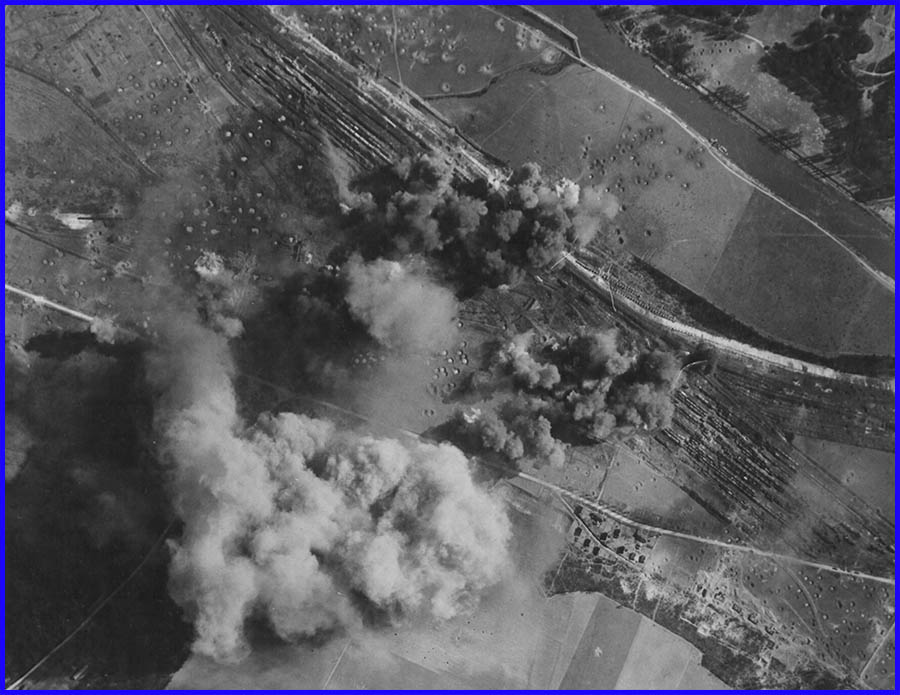
Petit-Thérain : bombing of 28th March 1944 around noon by the 9th US Army Air Force
(source NARA)
The attacks on southern England by the V1 flying bombs are a real menace for the people.
Steve Darlow, in his book "Sledgehammers for Tintacks" gives the following figures for the losses due to the V1s :
6,184 civilians killed, 17,981 seriously injured, 23,000 homes destroyed and hundreds of thousands damaged.
The bombing campaign, begun in 1943 (operation CROSSBOW) against the launching ramps, delayed and limited the number of V1s fired but did not annihilated them.

Aerial reconnaissance photograph dated 13th June 1944
On 29th June 1944, the depot of St-Leu (code LEOPOLD) becomes a priority target for Bomber Command to destroy the source of the launching ramps (two other depots are targeted : Nucourt (code NORDPOL) in the Val d 'Oise, and Rilly-la-Montagne (code RICHARD), in the Marne.
The raids on St. Leu and St. Maximin by the RAF, result a considerable number of casualties among the bomber crews :
54 four-engined aircraft destroyed, 264 airmen killed, 45 taken prisoner and 62 rescued in the Oise department and the neighbouring departments.
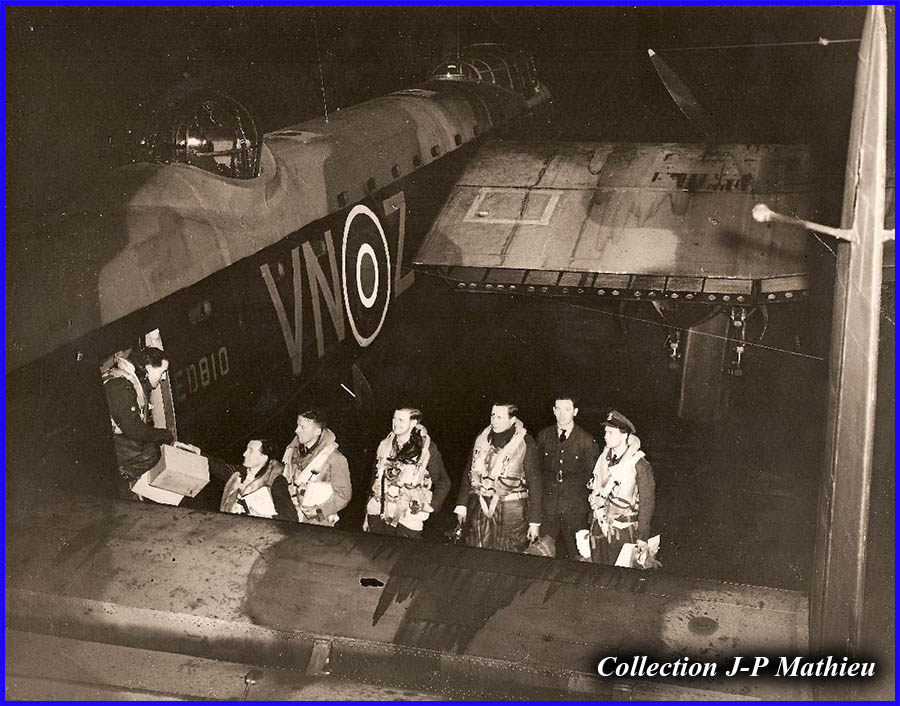
The first raid by the Royal Air Force takes place on Saint-Leu in the late afternoon of Tuesday 4th July 1944.
17 Lancasters, 1 Mosquito and 1 Mustang of the famous 617 Squadron, nicknamed the "Dambusters", drop 11 Tallboy bombs. The dust and the smoke generated by the terrible explosions prevent the release of six other giant bombs. Not one aircraft is lost.
The second raid is an immediate consequence of the first and takes place on the night of 4th to 5th July 1944.
231 Lancasters 15 Mosquitos of the RAF 5th Group drop approximately 1,157 tons of explosive bombs and 5 tons of incendiary bombs in 3 waves between 1:31 am and 1:45 am (UK Time). The bombardment is reported as accurate by the RAF. The town of Saint-Maximin, although not targeted, is hit hard. 13 Lancasters do not make it back to England. The RAF suffers 77 airmen killed in action.
A German report intercepted by the British on 5th July indicates that the entrance of the quarry is not affected, the access road and railway track are destroyed although repairable in 24 hours. Human losses at the depot amount to 5 men missing. Of the Flak gunners (AAA) 5 are killed, 6 are wounded and 6 or 7 are missing.
The third raid takes place, again over Saint-Leu, on the night of Friday 7th to Saturday 8th July 1944.
208 Lancasters and 13 Mosquitos of the 5th Group bomb, between 1:16 am and 1:30 am (UK Time), off loading, in 3 waves coming from the southwest, 1,121 tons of explosive bombs and 4 tons of incendiary bombs. 32 aircraft are lost. It is the deadliest bombing for the inhabitants of the town. 10 inhabitants lose their lives. The RAF suffer 142 killed in action and 30 taken prisoner but 47 airmen are rescued by individuals and the French Resistance.
Right: view of the quarry of the Couvent
(photos taken in September 1944)
The fourth raid takes place in the afternoon of Wednesday 12th July 1944.
168 Halifaxes, 46 Lancasters and 8 Mosquitos of the 4th, 6th and 8th Groups bomb the quarries of Thiverny. The target is covered in cloud and the result cannot be observed. Not one aircraft is lost.
The fifth raid targets the quarries of Trossy-Saint-Maximin. In the afternoon of Wednesday 2nd August 1944, 94 Lancasters and 8 Mosquitos drop 2,650 tons of bombs. All the aircraft return to their base.
The sixth raid again targets Trossy-Saint-Maximin. It takes place in the afternoon of Thursday 3rd August 1944.
191 Lancasters, 40 Halifaxes and 2 Mosquitos drop 1,700 tons of bombs. 5 Lancasters are lost. The smoke generated by the explosions considerably hampers the second wave. The town of Saint-Maximin is destroyed more than 90%.
The seventh attack consisting of 5 Mosquitos and 61 Lancasters bomb Trossy-Saint-Maximin takes place on Friday 4th August 1944. 2 Lancasters are destroyed.
The eighth and last raid targets Saint-Leu-d’Esserent again. Early in the afternoon of Saturday 5th August 1944, an initial armada of 456 aircraft of the RAF (441 take part in the raid, according to some sources), including 60 Lancasters, 196 Halifaxes and 7 Mosquitos for the first wave, then 189 Lancasters and 6 Mosquitos for the second, drop approximately 2,193 tons of bombs.
A Halifax crashes near the Carrefour des Ripailles (north of Chantilly), a second Halifax crashes on its return to England. The list of victims of the town grows since three inhabitants die during the attack.
The bombing of 5th August is the largest ever conducted over the Oise department. The municipalities of Gouvieux, Lamorlaye, Creil, but especially Précy-sur-Oise (12 killed) are not spared.
In early September 1944, after the Liberation, Saint-Leu-d'Esserent is a ghost town. Much of the 1,600 inhabitants had evacuated because of the bombings. The town is devastated at 85%, of which 45% totally. Apart from the area of the town hall miraculously spared, the people no longer recognize their town. It is just a scene of desolation and ruins.
Saint-Leu-d'Esserent : down the street Henri Barbusse Saint-Leu-d'Esserent : rue Christine
Saint-Leu-d'Esserent : near the Quai d'Amont Saint-Leu-d'Esserent : rue de l'Hôtel-Dieu
The church, jewel of the town, suffered severe destruction. Years of work will be needed for its restoration. Livestock has been decimated. The road Saint-Leu/Creil is no longer passable and this for many long months. No trains or barges circulate. Supplies are hard to come by. Everything is lacking.
On 20th October 1944, the municipality requests the adoption of the town by a British or an American city :
"Because of the extensive damage of the bombing ... which affected 85% of the population, historical monuments such as the church, much of the farmland and mushroom growing areas, the bombing also crippled local industry by the destruction of major industrial establishments (Candy, Petit-Thérain, the harbor wharfs etc ..). "
It may be noted that on 28th December 1944: "The gas and electricity work but the water supply is still being repaired. There are no means of transport for providing barracks for the victims".
In 1945, Saint-Leu-d'Esserent remains for many long years ravaged by war. A great number of people who suffered damage live in temporary cabins or in half-destroyed buildings. Supplies are insufficient and heating is difficult.

V1 rocket exhibited in Paris in 1945
On 11th November 1948, the 39/45 Croix de Guerre with a citation “à l’Ordre du Régiment” is awarded to the town of Saint-Leu-d'Esserent.
Since the end of WWII, many veterans of the RAF and families of those missing have come on pilgrimage to Saint-Leu-d'Esserent.

Insignia offered in October 1983 to the municipality of Saint-Leu-d'Esserent
by F/L Keith J. Stevens of the Royal Australian Air Force.
His Lancaster was shot down on the night of 7th to 8th July 1944.
31 civilians, including 16 inhabitants of Saint-Leu-d’Esserent, were killed during the different bombings of the year 1944. We can add 15 others killed in the neighbouring towns, Saint-Maximin, Précy-sur-Oise and Lamorlaye in August 1944 when the town of St. Leu was targeted.
The tonnage of bombs falling from the sky in July/August 1944 is estimated at 9,000 tons.
Date |
Aircraft |
Serial number |
Squadron |
Target |
Killed |
POW |
Evaded |
| 4-5 July 1944 | Lancaster | LL785 | 9 | Saint-Leu | 8 | - | - |
| 4-5 July 1944 | Lancaster | ME699 | 44 | Saint-Leu | 6 | - | 2 |
| 4-5 July 1944 | Lancaster | PB195 | 49 | Saint-Leu | 7 | - | - |
| 4-5 July 1944 | Lancaster | JB486 | 57 | Saint-Leu | 7 | - | - |
| 4-5 July 1944 | Lancaster | JB723 | 57 | Saint-Leu | 7 | - | - |
| 4-5 July 1944 | Lancaster | EE186 | 61 | Saint-Leu | - | 5 | 2 |
| 4-5 July 1944 | Lancaster | ME832 | 106 | Saint-Leu | 6 | - | 1 |
| 4-5 July 1944 | Lancaster | ND339 | 106 | Saint-Leu | 1 | 2 | 4 |
| 4-5 July 1944 | Lancaster | LM125 | 207 | Saint-Leu | 7 | - | - |
| 4-5 July 1944 | Lancaster | ND570 | 207 | Saint-Leu | 6 | 1 | - |
| 4-5 July 1944 | Lancaster | HK536 | 463 | Saint-Leu | 7 | - | - |
| 4-5 July 1944 | Lancaster | ME614 | 463 | Saint-Leu | 8 | - | - |
| 4-5 July 1944 | Lancaster | ME867 | 630 | Saint-Leu | 7 | - | - |
| 7-8 July 1944 | Lancaster | JA690 | 9 | Saint-Leu | 1 | - | 7 |
| 7-8 July 1944 | Lancaster | JA957 | 9 | Saint-Leu | 6 | - | 1 |
| 7-8 July 1944 | Lancaster | JB116 | 9 | Saint-Leu | 4 | 3 | - |
| 7-8 July 1944 | Lancaster | LM631 | 44 | Saint-Leu | 2 | - | 5 |
| 7-8 July 1944 | Lancaster | ME634 | 44 | Saint-Leu | 2 | 3 | 2 |
| 7-8 July 1944 | Lancaster | ME859 | 44 | Saint-Leu | 7 | - | - |
| 7-8 July 1944 | Lancaster | LL976 | 49 | Saint-Leu | 7 | - | - |
| 7-8 July 1944 | Lancaster | LM541 | 49 | Saint-Leu | 7 | - | - |
| 7-8 July 1944 | Lancaster | PB207 | 49 | Saint-Leu | - | - | - |
| 7-8 July 1944 | Lancaster | DV227 | 50 | Saint-Leu | 7 | - | - |
| 7-8 July 1944 | Lancaster | DV363 | 50 | Saint-Leu | 7 | - | - |
| 7-8 July 1944 | Lancaster | PA996 | 50 | Saint-Leu | 6 | - | 1 |
| 7-8 July 1944 | Lancaster | JB370 | 57 | Saint-Leu | - | 3 | 4 |
| 7-8 July 1944 | Lancaster | LM522 | 57 | Saint-Leu | 7 | - | - |
| 7-8 July 1944 | Lancaster | ME868 | 57 | Saint-Leu | 3 | 1 | 2 |
| 7-8 July 1944 | Lancaster | ND867 | 61 | Saint-Leu | 5 | 1 | 1 |
| 7-8 July 1944 | Lancaster | R5856 | 61 | Saint-Leu | 7 | - | - |
| 7-8 July 1944 | Lancaster | ND966 | 83 | Saint-Leu | 5 | 1 | 1 |
| 7-8 July 1944 | Lancaster | JB641 | 106 | Saint-Leu | 7 | - | - |
| 7-8 July 1944 | Lancaster | ME668 | 106 | Saint-Leu | 4 | 3 | - |
| 7-8 July 1944 | Lancaster | ME789 | 106 | Saint-Leu | - | 6 | 1 |
| 7-8 July 1944 | Lancaster | ME831 | 106 | Saint-Leu | - | 2 | 5 |
| 7-8 July 1944 | Lancaster | PB144 | 106 | Saint-Leu | 7 | - | - |
| 7-8 July 1944 | Lancaster | LM129 | 207 | Saint-Leu | 3 | 3 | 1 |
| 7-8 July 1944 | Lancaster | LM218 | 207 | Saint-Leu | 5 | - | 2 |
| 7-8 July 1944 | Lancaster | ME805 | 207 | Saint-Leu | - | 2 | 5 |
| 7-8 July 1944 | Lancaster | ND567 | 207 | Saint-Leu | 5 | 1 | 1 |
| 7-8 July 1944 | Lancaster | ND866 | 207 | Saint-Leu | 6 | 1 | - |
| 7-8 July 1944 | Lancaster | LM219 | 467 | Saint-Leu | 6 | - | 2 |
| 7-8 July 1944 | Lancaster | LM338 | 467 | Saint-Leu | 7 | - | - |
| 7-8 July 1944 | Lancaster | ME745 | 619 | Saint-Leu | 2 | - | 5 |
| 7-8 July 1944 | Lancaster | ND688 | 630 | Saint-Leu | 6 | 1 | - |
| 3 August 1944 | Lancaster | PA162 | 61 | Saint-Maximin | 6 | - | 1 |
| 3 August 1944 | Lancaster | ME839 | 166 | Saint-Maximin | 5 | 1 | 1 |
| 3 August 1944 | Lancaster | PB125 | 460 | Saint-Maximin | 7 | - | - |
| 3 August 1944 | Lancaster | ME568 | 619 | Saint-Maximin | 7 | - | - |
| 3 August 1944 | Lancaster | LM163 | 625 | Saint-Maximin | 2 | 4 | - |
| 4 August 1944 | Lancaster | PA983 | 635 | Saint-Maximin | 8 | - | - |
| 4 August 1944 | Lancaster | ND811 | 635 | Saint-Maximin | 3 | - | 4 |
| 5 August 1944 | Halifax | LL594 | 425 | Saint-Leu | 6 | 1 | 1 |
| 5 August 1944 | Halifax | MZ828 | 433 | Saint-Leu | 2 | - | - |
| TOTAL OF LOSSES | 54 | 264 | 45 | 62 |

2 August 1944
2nd Lt. Gerald C. CHAPMAN
P-51B « Mustang » # 43-6846
VF-A
4th Fighter Group
336th Fighter Squadron
8th Air Force
Le Mesnil-sur-Bulles (Oise)
Copyright © 2014 - Association des Sauveteurs d'Aviateurs Alliés- All rights reserved -
En français ![]()
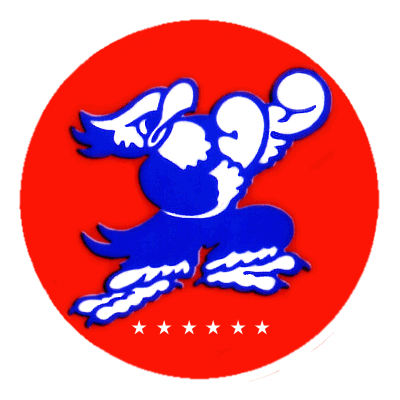
4th Fighter Group
Born on 16th September 1923, 2nd Lt. Gerald C. Chapman came from Stoughton, a town south of Boston, Massachusetts. Trained for many months in the United States, he was sent to the European Theater of Operations in December 1943 and assigned to the 4th Fighter Group based in Debden, Essex.

2nd Lt. Gerald C. Chapman
On 2nd August 1944, a patrol of "Mustangs" of the 4th Fighter Group including 2nd Lt. Chapman took off from the Debden Air Force base. Led by Captain Otey M. Glass Jr, their mission was to search over France for potential enemy targets to strafe. The mission almost completed, the "Mustangs" were preparing to return to England when they flew over the Beauvais-Tillé German airfield. Preparing to strafe possible aircraft on the ground, anti-aircraft batteries protecting the base began to target the attackers who were forced to disperse in a sky with poor visibility.
East of Beauvais, the "Mustang" piloted by 2nd Lt. Gerald C. Chapman was again targeted by a German mobile anti-aircraft battery positioned on the edge of the Bois de Mont to protect the large fuel depot located there. The German gunners fired on 2nd Lt. Chapman’s "Mustang" as it approached at low level.
Hit head-on and immediately catching fire, the out-of-control and destabilized aircraft crashed into a field near Huyard Woods, close to the road between Fournival and Le Mesnil-sur-Bulles, about 400 meters from the German battery, leaving the young 20-year-old pilot no chance to evacuate his plane. It was about 8:30 p.m.
It was harvest time. Witnesses working in a nearby field recalled the plane crashing. The Mustang's engine was torn apart on impact and thrown into the woods on the other side of the road.

Crash site
The pilot's horribly mutilated body was taken away by the Germans. The dog-tag found on his body allowed his identification. On 5 August, they buried him in the Beauvais-Marissel cemetery. His grave, surmounted by a British-style metal cross, bore the inscriptions found on his identification plaque: "0-815581 T43 S43 AP, Gerald C. Chapman USAAF 2-8-44."
Several months after the Liberation, members of an American commission inspected his grave and confirmed the pilot's identity. On 15th June 1945, 2nd Lt. Chapman's remains were transferred to the U.S temporary cemetery in Champigneul, Marne. The pilot's family was then contacted to see if they wished to have his body repatriated to the United States. They choose to keep it in France.
Exhumed once again on 23rd August 1948, the body of 2nd Lt. Gerald C. Chapman now rests in Epinal-Quépremont American cemetery, Vosges.
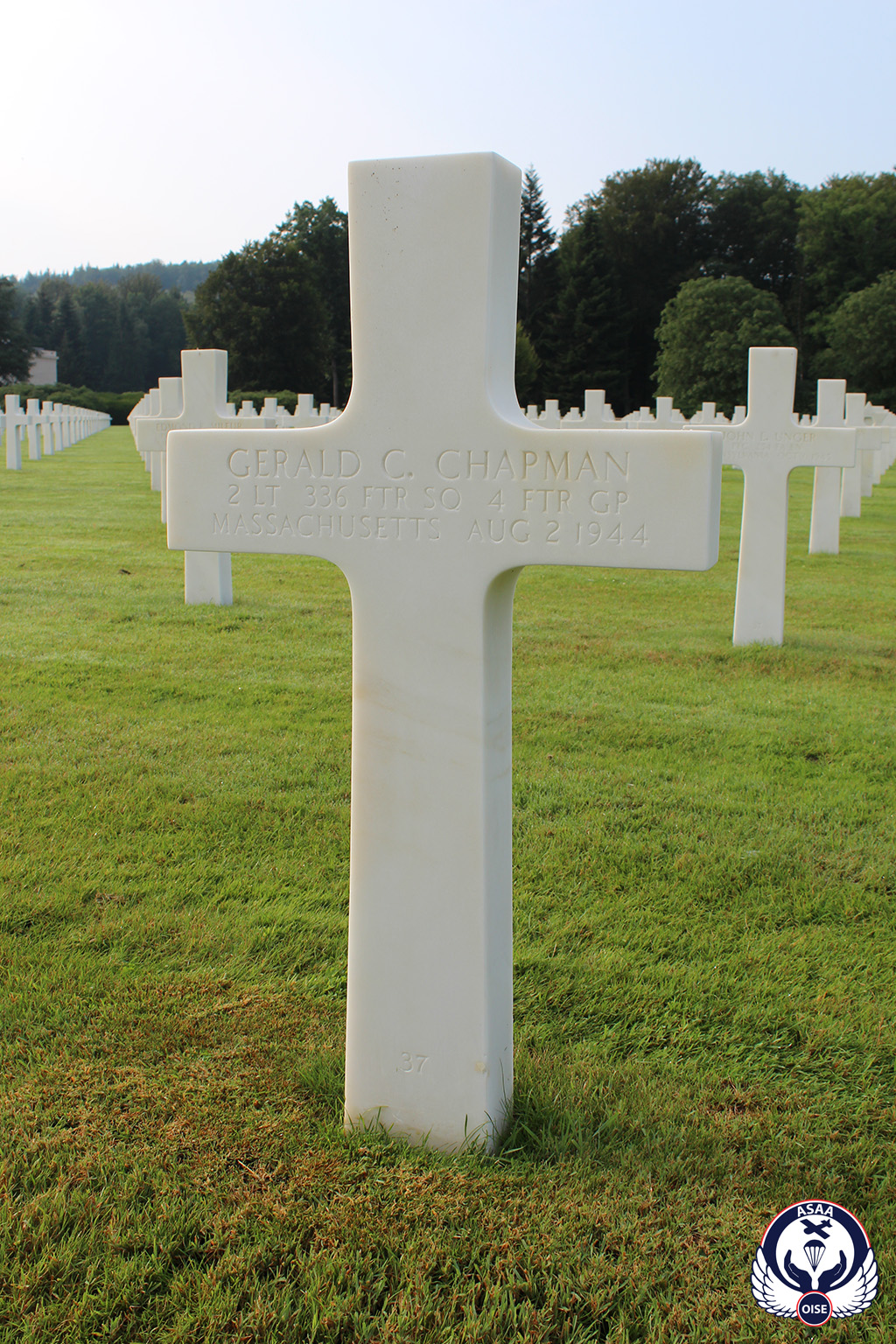
Epinal - Grave of 2nd Lt. Gerald C. Chapman


